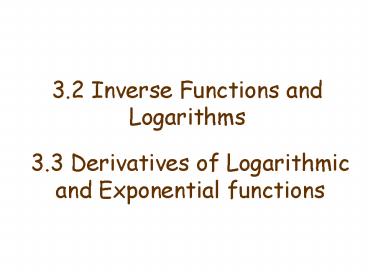3.2 Inverse Functions and Logarithms PowerPoint PPT Presentation
1 / 11
Title: 3.2 Inverse Functions and Logarithms
1
3.2 Inverse Functions and Logarithms
3.3 Derivatives of Logarithmic and Exponential
functions
2
One-to-one functions
- Definition A function f is called a one-to-one
function if it never takes on the same value
twice that is - f(x1) ? f(x2) whenever x1 ? x2.
- Horizontal line test A function f is one-to-one
if and only if no horizontal line intersects its
graph more than once. - Examples f(x) x3 is one-to-one
- but f(x) x2 is not.
3
Inverse functions
- Definition Let f be a one-to-one function with
domain A and range B. Then the inverse function f
-1 has domain B and range A and is defined by - for any y in B.
- Note f -1(x) does not mean 1 / f(x) .
- Example The inverse of f(x) x3 is f -1(x)x1/3
- Cancellation equations
4
How to find the inverse function of a one-to-one
function f
- Step 1 Write yf(x)
- Step 2 Solve this equation for x in terms of y
(if possible) - Step 3 To express f -1 as a function of x,
interchange x and y. The resulting equation is y
f -1(x) - Example Find the inverse of f(x) 5 - x3
5
Another example
Solve for x
Inverse functions are reflections about y x.
Switch x and y
6
Derivative of inverse function
First consider an example
At x 2
At x 4
7
Calculus of inverse functions
- Theorem If f is a one-to-one continuous function
defined on an interval then its inverse function
f -1 is also continuous. - Theorem If f is a one-to-one differentiable
function with inverse function f -1 and f ' (f -1
(a)) ? 0, then the inverse function is
differentiable and - Example Find (f -1 )' (1) for f(x) x3 x 1
- Solution By inspection f(0)1, thus f -1(1)
0 - Then
8
Logarithmic Functions
Consider where agt0 and a?1
This is a one-to-one function, therefore it has
an inverse.
The inverse is called the logarithmic function
with base a.
Example
The most commonly used bases for logs are 10
and e
9
Properties of Logarithms
Since logs and exponentiation are inverse
functions, they un-do each other.
Product rule
Quotient rule
Power rule
Change of base formula
10
Derivatives of Logarithmic and Exponential
functions
Examples on the board.
11
Logarithmic Differentiation
- The calculation of derivatives of complicated
functions involving products, quotients, or
powers can often be simplified by taking
logarithms. - Step 1 Take natural logarithms of both sides of
an equation y f (x) and use the properties of
logarithms to simplify. - Step 2 Differentiate implicitly with respect to
x - Step 3 Solve the resulting equation for y'
- Examples on the board

